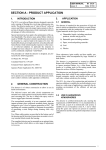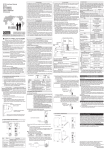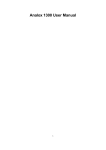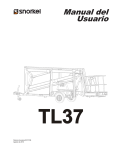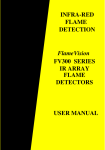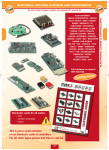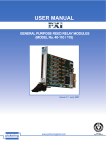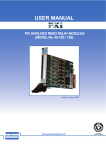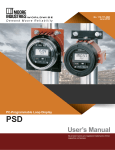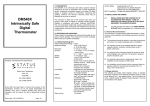Download section a - product application
Transcript
USER MANUAL Issue: 2 IR S161 Date: 01/94 SECTION A - PRODUCT APPLICATION 1. INTRODUCTION The S161 is an infra-red flame detector designed to provide early warning of flaming fires involving carbonaceous materials. The detector makes use of “state of the art” infrared sensors and filters to provide major improvements in the rejection of deceptive phenomena while retaining the inherent advantages of infra-red detectors. Special attention has been paid to the optimisation of the optical bandwidth. The detector uses optical filters which are made to THORN Security Limited's specification to restrict the response to a narrow bond in the region of 4.4mm. The bandwidth chosen gives high sensitivity to hydrocarbon fires while minimising the response to other sources of infra-red radiation. In particular the response to sunlight has been reduced to a level at which the detector can be considered completely “solar-blind”. The complete detector may be mounted on an optional stainless bracket which allows a wide range of adjustments in two axes. 3. APPLICATION 3.1 GENERAL The detector is intended for the protection of high risk areas in which accidental fires are likely to result in flaming combustion with the production of carbon dioxide. Typical materials in this type of risk are: a) Flammable liquids, including petroleum products, alcohol and glycol etc., b) flammable gases including methane, The principles on which the detector is designed, are protected by the following patterns: c) paper, wood and packing materials, US Patent No. 4471221 e) plastics. d) coal, Canadian Patent No. 1191229 European Patent Application No. 823107462 Japanese Patent Application No. 62667/82 The detector is electrically compatible with most conventional 2-wire fire detection systems. The circuit techniques used, together with the mechanical design, allows the detector to be certified for use in hazardous atmospheres. The hazardous area classification, together with the mechanical design, allows the detector to be used as a replacement for flameproof detectors using existing Ex d wiring. 2. GENERAL CONSTRUCTION The detector is of robust construction to allow its use in harsh environments. The infra-red sensor and other circuit components are mounted on a single printed circuit board within a stainless steel screening box. The box is filled with epoxy resin to form a rugged opto-electronic assembly. The encapsulated assembly along with an encapsulated interface unit is in turn contained within an impact-resistant glass reinforced moulded plastic housing designed to give a level of ingress protection to IP67. The moulding mix contains graphite to eliminate the possibility of generating a static charge during cleaning with a dry cloth. These substances ignite readily and burn rapidly, producing flame, often accompanied by large volumes of dark smoke. Note: The detectors are not designed to respond to flames emanating from fuels which do not contain carbon e.g. hydrogen, ammonia, metals, and should not be used for such risks without satisfactory fire testing. The S161, by virtue of its construction and rejection of spurious radiation, is suitable for use both indoors or outdoors in a wide range of applications. 3.2 USE IN HAZARDOUS ATMOSPHERES The detector design uses the techniques of intrinsic safety, encapsulation and increased safety to achieve a classification of Ex e s ib IIC T5. This classification allows the detector to be used without a zener safety barrier as a direct replacement for detectors certified Ex d (flameproof). How- ever the circuit wiring must comply with Ex d or Ex e requirements and the use of BASEEFA certified glands rated Ex e is mandatory. Two 20mm cable entries are provided in one side of the housing and all electrical connections are made to two 4way blocks and an end of line terminal block housing. A cable gland plate, secured inside the metal cable glands (not provided) enable screen continuity. 1 4. BENEFITS OF THE S161 Infra-red flame detectors offer certain benefits over detectors working in the visible or ultra-violet regions of the spectrum. For example they are: a) Highly sensitive to flame thus increasing probability of early detection of hydrocarbon fires, b) not greatly affected by window contamination by dirt and oil deposits thus decreasing maintenance frequency leading to operating cost reduction, c) able to see flames through smoke and able to see flames through high densities of solvent vapours thus increasing the probability of early detection of hydrocarbon fires over other (ultra-violet) detectors in the same conditions, The S161 has all the above benefits and additionally it is: d) completely “solar-blind” in normal conditions thus eliminating false alarms due to direct or indirect sunlight, e) insensitive to electric areas thus eliminating false alarms from welding operations, f) insensitive to artificial light sources, g) suitable for use in hazardous atmospheres as a direct replacement for detectors certified Ex d (flameproof), h) sealed to IP67 (when suitable cable glands are used) ensuring long term reliability in harsh environments. 2 5. ORDERING INFORMATION The S161 is supplied without a fitted bracket as in some applications detectors are bolted directly onto a bulkhead. A separate stainless steel 316 bracket is available for better applications. Stock Code Number: S161 Detector 516-009-022 Stainless Steel Bracket 517-001-184 USER MANUAL IR S161 Issue:2 Date: 01/94 SECTION B - SYSTEM DESIGN INFORMATION 1. INTRODUCTION The design of a system incorporating S161 flame detectors must take account of the detector's electrical, mechanical and environmental characteristics, and its detection performance. This information is given below together with guidance on detector siting. 2. 2.1 ELECTRICAL CHARACTERISTICS GENERAL The S161 is a two-wire device which is designed to operate on any fire detection control equipment currently manufactured by THORN Security Limited or similar fire detection controllers. The quiescent current drain is very small and the alarm condition is latched in the detector and signalled by a large increase in current demand. Resetting is achieved by removing the supply voltage for a period of at least five seconds. An interface unit is located inside the front cover adjacent to the detector module. The Interface Unit is advice which limits the power transferred to the detector module to a safe level. The end to end resistance of the Interface Unit is nominally 373 ohms. 2.2 TECHNICAL DATA Supply Voltage: 18.0V to 24.0V d.c. (polarity conscious) Quiescent Current: 100mA max at 20V d.c. Alarm Output Mode: 2-wire, latching 720 ohm in series with typically 4V switched across supply. Fig. 1 In-rush Current: 800mA peak decreasing with a time constant of 250ms to the quiescent current. Alarm Indication: red LED visible from front of detector. Reset Time: Not greater than 1 second. Reset Voltage: Supply must be reduced to less than 2V. Stabilisation Time: 20 seconds (typical) End of Line Resistors: 0.6 Watt minimum, 2k4 minimum metal film 5% not smaller than 2.5mm diameter and 10mm long, actual resistor value dependent on controller. Detectors from serial number 16000 onwards have been modified to facilitate their use with control panels not manufactured by THORN Security Limited, where the reset is short. The reset facility is implemented as follows: a) For fast reset to operate it is necessary for the supply to be removed for a minimum of 0.5 seconds, b) the supply must fall by greater than 5 Volts, c) the detector [or Zone] must have an end-of-line resistor with a resistance of less than 100k, d) the noise immunity on the line [ripple] is less than 3 Volts peak. S161 Connection and Internal Wiring Including EOL 3 Fig. 2 3. 3.1 S161 Cover MECHANICAL CHARACTERISTICS 4. GENERAL The design and construction of the S161 is such that it may safely be used over a wide range of environmental conditions. Relevant limits are given in para. 4.2. The detector comprises a two-part moulded plastic enclosure as shown in Figs. 2 and 3. The rear section of the housing is attached to an optional adjustable mounting bracket or the detector may be fitted directly to a suitable surface. 4.1 4.2 ENVIRONMENTAL GENERAL TECHNICAL DATA The front section of the enclosure contains the encapsulated electro-optical assembly and the interface unit which is connected to the terminal blocks by a small cableform. Two sapphire windows are fitted in the front of the housing. The upper window allows infra-red radiation to fall on the sensor and the LED alarm indicator is visible through the lower window. 4.2.1 The front section of the enclosure is attached to the rear section by four captive screws. A seal provided between the front and rear sections ensures protection to IP67. Enclosure Protection: IP67 - IEC529, BS5490 Operating temperature range: -20oC to +80oC (-40oC with reduced range) Storage temperature range: -40oC to +80oC Relative humidity: 95% (100% intermittent) 4.2.2 3.2 TECHNICAL DATA VIBRATION The S161 is designed to operate within specification and without false operation when subjected to vibration on any axis at the following levels: Dimensions: 160mm x 160mm x 90mm without bracket (see Figs. 4 and 5). Weight: 2.0kg (with optional bracket) 2 - 24Hz +1.27mm Enclosure: Glass reinforced polyester with an anti-static graphite content, interior & exterior metal fittings of stainless steel. 24 - 55Hz 2.50g 55 - 100Hz 0.7g Mounting Bracket: Bright Stainless steel to BS1449 Pt 2 316S16. Screws, etc. exposed to the elements: Bright Stainless Steel to BS970 Pt1 316L. 4 TEMPERATURE AND HUMIDITY 4.2.3 5.1.1 RADIO FREQUENCY INTERFERENCE The detector is insensitive to radio frequency interference and will operate normally in field strengths of 10V/m at frequencies up to 1000MHz. It thus meets or exceeds the requirements of BS6667: Part 3 1985 (IEC 801-3: 1984) severity level 3 (severe electromagnetic environments). 4.2.4 IONISING RADIATION The S161, like other infra-red detectors, is insensitive to Xrays and gamma radiation as used in non-destructive testing. The detector will operate normally and will not false alarm when exposed to this type of radiation although long term exposure to high radiation levels will ultimately lead to permanent damage. 5. 5.1 PERFORMANCE CHARACTERISTICS GENERAL A large number of fire tests have been carried out to determine the response limits of the S161 detector. The results of these tests are summarised below. In order to appreciate their significance, an understanding of the mode of the operation of the detector is necessary, and a brief explanation follows: Fig. 3 MODE OF OPERATION BEHAVIOUR IN FIRE TESTS Flaming fires involving carbonaceous materials produce large quantities of carbon dioxide. This part of the combustion process gives rise to a very high level of infrared radiation in the wavelength region between 4.2µm and 4.7µm. The unique patented filtering system of the S161 Detector restricts the radiation reaching the sensing cell to a narrow band of infra-red radiation in the region of 4.4µm. The radiation from a fire flickers in a characteristic way and the detector uses this flicker signal to give extra discrimination against interfering infra-red sources. The detector circuit analyses the signal within the flicker frequency region and, if the amplitude of the signal is above a preset threshold level for three seconds, then an alarm is signalled. If the signal is below this threshold level then the detector will not alarm even after a long period of time. The level of the signal depends upon the size of the flame and its distance from the detector. For liquid fuels the level is roughly proportional to the surface area of the burning liquid. For any type of fire the signal level varies inversely with the square of the distance. S161 Housing Showing Fixing Dimensions 5 For convenience, fire tests are normally carried out using liquid fuels burning in pans of known area in still air. The sensitivity of a detector can then be conveniently expressed as the distance at which a particular fire size can be detected. It is important to think in terms of distance rather than time because of the different burning characteristics of different fuels. Fig. 5 shows the response to two different fuels which ultimately produce the same signal level. Fig. 4 Mounting Bracket Fig. 5 6 The signal level given by petrol quickly reaches its maximum, and produces an alarm within about six seconds of ignition. Kerosene, on the other hand, being less volatile, takes about a minute to reach equilibrium and an alarm is given in about 55 seconds from ignition. The time taken by the fire to reach equilibrium depends of course on the initial temperature of the fuel. If the Kerosene were to be preheated to a temperature above its flash point then its behaviour would be equivalent to that of petrol at 25oC. The test data presented below refers to fires which have reached their equilibrium condition. Stockcode 517-001-184 Response to Fires Fig. 6 5.2 Detection Ranges vs Pan Area - Petrol 5.3 FIRE TEST DATA 5.2.1 PETROL The most convenient fuel for fire tests is petrol (gasoline) since it is readily available and quickly reaches its equilibrium burning rate. The graph in Fig. 6 shows the detection range as a function of pan area for petrol fires. It will be seen that this curve is approximately a square law that is to say that to obtain detection at twice the distance the pan area must be multiplied by four. The sensitivity of the detector is constant over the voltage range +18.0V to +24.0V d.c. The performance outside this range is not guaranteed. 5.4 OTHER LIQUID HYDROCARBONS Ranges achieved with other fuels burning on 0.1m2 pans are as follows: TEMPERATURE DEPENDENCE The range of the detector will vary by less than +10% over the range of -20oC to +70oC. 5.5 5.2.2 VOLTAGE DEPENDENCE DIRECTIONAL SENSITIVITY The sensitivity of the S161 is at a maximum on the detector axis. The variation of range with angle of incidence is shown in Fig. 7. n-heptane 18m Kerosene 18m 6. DESIGN OF SYSTEM Alcohol (I.M.S.) 15m 6.1 GENERAL Diesel oil 15m Ethylene glycol 18m Using the information given in paras. 2 to 5 it is possible to design a flame detection system having a predictable performance. Guidance on the application of the above data and on siting of detectors of given below. The detection range for other pan areas may be calculated using the square law relationship given in para 5.2.1. 5.2.3 GAS FLAMES Most flammable gases contain carbon, and the radiation produced when such gases burn is easily detected by the S161. Additionally, tests have shown that “accidental” fires involving gases will produce sufficient flicker to give rapid alarm response from the detectors. This is equally true for fires resulting from low pressure [(less than 0.5 lb/in2 (0.035 kg/cm2))] leaks. Typical results obtained by burning natural gas (methane) from a 1 inch (25.4mm) diameter pipe are given below: GAS PRESSURE (lb/in2) (kg/cm2) DETECTION RANGE (metres) 0.5 0.035 30 1.0 0.070 30 5.0 0.351 50 25.0 1.758 60 6.2 USE OF FIRE TEST DATA It has been explained in Para 5 that the sensitivity of the detector is most easily specified in terms of its response to well-defined test fires. Tests are conveniently carried out using a 0.1m2 pan. Sensitivity to other pan areas is calculated from the square law relationship. Accidental fires by their very nature rarely of a well-defined size. It is still possible however to judge the response to a p fire using the fire test data. For a example. A spillage fire involving a highly volatile liquid such as petrol will spread very quickly from the point of ignition to cover the complete surface of the pool. Such a spillage would normally cover 2m2 or so. Using the data for petrol fires and extrapolating to an area of 2m2 we would expect the S161 to respond within 10 seconds at a distance of about 80 metres. At a distance of 20 metres the response time would only be a few seconds less and in any event can never be less than 3 seconds. 7 c) the S161 may be used to look vertically downwards on to a risk area since smoke blocking is minimal, If on the other hand the spillage involved a less volatile material such as kerosene, the spread of flame from the ignition point would be much slower. The detector would then respond in a time independent on the distance from the fire. At 18 metres, for example, an alarm would be given when the fire had reached 0.1m2 and at 36 metres, when the fire had grown to 0.4m2. 6.3 DETERMINING NUMBER OF DETECTORS It will be clear that the number of detectors required for a particular risk will depend on the area involved and the fire size at which detection is required. Large areas or small fires require large numbers of detectors. There are as yet no agreed “rules” for the application of flame detectors and the overall system sensitivity must therefore be agreed between the installer and the end user. Once this agreement has been reached the system designer can determine the area covered by each detector using a scaled plot based on Fig. 7 and the fire test data. This plot is best drawn to the same scale as the site plan so that direct imposition can be used to determine detector coverage. In carrying out the design, certain factors should be kept in mind: a) For area rather than spot protection, the best coverage will normally be obtained mounting the detectors on the perimeter of the area and pointing into the area, b) as the S161 is a line of sight detector any object within the detector's field of view will cause a “shadow” in the protected area. Even small objects close to the detector can cause large shadows Fig. 7 8 d) the detectors are passive devices and will not react with one another. They may therefore be positioned with their fields of view overlapping. 7. APPROVALS AND COMPLIANCE WITH STANDARDS 7.1 SAFETY The S161 has been certified by BASEEFA for use in hazardous atmospheres under certificate number Ex 87Y3550. It is classified: Ex e s ib IIC T5, indicating a primary means of protection of Ex “e” (increased safety). It is therefore suitable for use in zone 1 or zone 2 areas if installed to the requirements of BS5345 : Parts 6 and 8. 7.2 OTHER STANDARDS The S161 is a development from S111 offering a more robust housing. The S111 has been submitted to independent tests which show that it meets all the requirements of the “C.E.A. Test Methods for Point Infra-red Flame Detectors” up to its designed angle of vision of 90o. 7.3 OTHER APPROVALS The complete list of approvals for ALL equipment is given in THORN Publication 05A-01-G1 which is updated at regular intervals. Relative Range vs Angle of Incidence USER MANUAL Issue: 2 IR S161 Date: 01/94 SECTION C - INSTALLATION 1. GENERAL The S161 detector is supplied with the option of an adjustable mounting brackets for fixing to a convenient rigid surface. All electrical connections are made via the two 4-way terminal blocks and an end of line terminal block inside the detector housing. Two 20mm cable entries are provided. Guidance on mounting and wiring the detectors is given below. A cable gland plate, secured inside the housing by metal Ex d (flameproof) cable glands, provides screen continuity. 2. MOUNTING A DETECTOR The location of each detector should have been determined at the system design stage according to the principles detailed in Section B marked on the site plan. The detector may be mounted on a horizontal or vertical surface. The actual mounting position must, however, be decided during installation, and in choosing the position the principles following together with the original system requirements should be followed. Fig. 1 2.2 2.1 CHOICE OF MOUNTING POSITION The following points must be observed when choosing the mounting position. a) The detector must be positioned such that a clear line of sight is provided to all parts of the risk area. Roof trusses, pipework, supporting columns etc. in front of the detector can cause significant shadowing and should be avoided, b) if supervision of an area immediately below the detector is required it is essential that the angle between the detector and the horizontal is not less than 40o, Detector Fixing Dimensions MOUNTING BRACKET The detector mounting bracket is to be secured with two M8 bolts, studs or screws at the fixing centres shown in Fig. 1. A drilling template is provided to allow the optimum selection of the fixing centres and the 2.5mm diameter, 3mm deep pivot hole. The surface chosen for the mounting should be flat over the area of the bracket or detector to ensure a stable fixing. The S161 may be operated in any position but the actual mounting point must obviously be chosen to allow sufficient clearance for adjustment of the angle and must also allow space for the cable assembly. A clearance of 200mm, in all directions, from the fixing point will normally be sufficient to allow the full range of adjustment. Fig. 2 refers. c) the detector should not be sited in a position where it will be continually subjected to water drenching, d) in outdoor installations in areas of high solar radiation, some form of sunshade is recommended to prevent excess heating of the detector, e) the detector should not be sited in a position in which it will be subject to severe icing, f) the detector must be mounted on a stable structure which is readily and safely accessible for maintenance staff. The detector may be secured directly to the fixing surface with two or more M6 bolts, studs or screws at the fixing centres shown in Fig. 1. Fig. 2 Clearance Required for Full Adjustment 9 Fig. 3 3. Detector Wiring DETECTOR WIRING Detectors will normally be connected in zones which may contain up to ten detectors. All detectors on a zone are connected in parallel and some form of end-of-line device should be used to monitor line continuity. The wiring between the detectors and control equipment must provide the required degree of mechanical protection but allow the detector alignment to be adjusted to suit the area to be protected. The detector is fitted with two 4-way terminal blocks giving separate terminal blocks for incoming and outgoing lines. The two 20mm cable entries provided permit convenient connection of the incoming and outgoing lines using metal flameproof cable glands with continuity of cable screens provided by the cable gland plate. To ensure no moisture ingress to the detector during the time between Installation and Commissioning tighten the four hexagonal socket cover retaining screws to torque of 3.5-4.5N.m (2.6 - 3.3lbf.ft). The End-of-Line Resistor (0.6 Watt minimum. 2k4 minimum. metal film 5% not smaller than 2.5mm diameter and 10mm long, actual resistor value dependent on controller) should be fitted at the EOL Terminal Block of the last detector situated in the right hand side of the cover as shown in Fig. 3. 3.1 RECOMMENDED CABLE TYPES The cable selected for interconnection to the control equipment should meet the requirements of BS5345: parts 1 & 6 or relevant approval bodies. Cables should not normally have a cross sectional area of less than 1mm2 for solid conductors or 0.5mm2 for stranded conductors. The terminal block accepts cables up to 4mm2 cross sectional area. 10 4. INITIAL WIRING CHECK After installing the wiring as detailed above, and before connecting any detectors or end-of-line devices, the following tests should be carried out. 4.1 TESTS ON WIRING IN HAZARDOUS AREAS When carrying out tests on wiring in hazardous areas it is essential than an INTRINSICALLY SAFE INSULATION TESTER is used. Further guidance on testing systems in hazardous areas can be found in BS5345: Part 1. 4.2 CONTINUITY TESTS To check continuity proceed as follows: a) Short together the bare tails of the + to + and - to - at each detector, b) short together the pair at the end furthest from the control equipment, c) using an ohmmeter set to its lowest range, check the loop resistance at the control equipment end, d) if the reading obtained is less than 50 ohms record the reading obtained and proceed to para 4.3, e) if the reading obtained is greater than 50 ohms locate and rectify continuity faults by quartering the system. 4.3 INSULATION TESTS To check the insulation proceed as follows: a) Using an ohmmeter set to its highest range, check the resistance between the circuit and earth, b) if the reading obtained is greater than 1 megohm, record the reading and proceed to c), otherwise locate and rectify the earth fault, c) remove the short-circuit at the end furthest from the control equipment, d) measure the resistance between the zone conductors, e) if the reading obtained is greater than 1 megohm, record the reading, otherwise locate and rectify the insulation fault, f) replace the cover. 11 USER MANUAL Issue: 2 IR S161 Date: 01/94 SECTION D - COMMISSIONING 1. e) at this stage the angle of the detector should be adjusted to view the required area and the fixing nuts and bolts finally tightened. The cable from the circuit to the detector should then be routed, using cable ties or clips as necessary, to minimise the risk of physical damage, SYSTEM CHECKS Before connecting the zone wiring to the control equipment or to the detectors, a general inspection of the system should be carried out. In particular the positions of the detectors should be checked to ensure that the requirements given in the System Design and Installation sections are met. 2. CONNECTING AND COMMISSIONING THE DETECTORS 2.1 TESTS ON WIRING IN HAZARDOUS AREAS When carrying out tests on wiring in hazardous areas it is essential than an INTRINSICALLY SAFE INSULATION TESTER is used. Further guidance on testing systems in hazardous areas can be found in BS5345: Part 1. f) commission the controller as necessary. 2.3 DETECTOR TESTING HAZARDOUS AREAS The use of naked flames for detector testing in hazardous areas is obviously unacceptable. The T110 Test Source has been designed specifically for the on-site testing of the S100 Series on infra-red flame detectors in hazardous areas. When testing the S161, the correct adaptor plate must be fitted to the T110 Test Source. S161 Adaptor Plate 2.2 COMMISSIONING PROCEDURE WARNING: ENSURE THE SUPPLY TO THE DETECTOR IS ISOLATED BEFORE OPENING THE COVER. Stock Code No: 592-001-005 Note: The T110 has a charge/discharge circuit which take several seconds to recharge. Consequently, the T110 does not test the response time of a detector but only tests for response to a flame. The T110 tests the S161 with a defined energy at a opened distance, indicating reliably when the S161 is operating above 75% of its specified performance levels. Carry out the following procedure: a) Repeat the HV and LV insulation and continuity tests carried out by the installation engineer. Record the results obtained, b) connect the loop wiring at each detector terminal block, c) check the correct value EOL resistor is fitted at the EOL terminal block in the last detector, d) fit the front cover assembly to the rear section. care should be taken to ensure that the internal wiring is not trapped between the terminal blocks and the front assembly. It should be noted that a rubber seal is provided between the front and rear sections of the housing and this seal must be clean and dry before assembly. It is also important to ensure that no moisture is trapped inside the housing. Tighten the four hexagonal socket retaining screws to a torque of 3.5 - 4.5 N.m (2.6 - 3.3lbf.ft), 12 USER MANUAL Issue: 2 IR S161 Date: 01/94 SECTION E - MAINTENANCE 1. GENERAL The S161 detector contains encapsulated electronic assemblies. There are no replaceable or adjustable components within the housing, which should not be opened once installed and commissioned. Routine maintenance is therefore limited to cleaning and testing the detectors. 1.1 ROUTINE INSPECTION At regular intervals of not more than 3 months, detectors should be visually inspected to confirm that no physical damage has occurred and that the alignment of the detectors has not been disturbed. The detector windows should be checked to confirm that they are not blocked and that no physical obstructions have been placed between the detector and the protected area. 1.2 DETECTOR CLEANING The S161 Infra-red detector is relatively tolerant of accumulations of dirt on the sensor window. However, thick deposits of dirt and oil will cause a loss of sensitivity. It is recommended that detectors be cleaned using water or a detergent solution. A stiff bristle (not wire) brush may be sued to remove heavy deposits. Note: The act of cleaning or polishing the detector face and window may cause a detector to produce an alarm, it is important, therefore that before the window is cleaned, the detector should be isolated. By isolating the relevant circuit at the control unit. The circuit must be de-isolated as soon as cleaning is complete. In addition, at intervals of not more than 1 year, each detector should be checked for correct operation. Any excessive deposits of dirt, oil etc. should be removed from the detector housing as described in 1.2. Note: The inspection frequency specified above should be considered as a minimum requirement to be applied in the average environment. The inspection frequency should be increased for dirtier environments or those which present a higher risk of physical damage. 13













